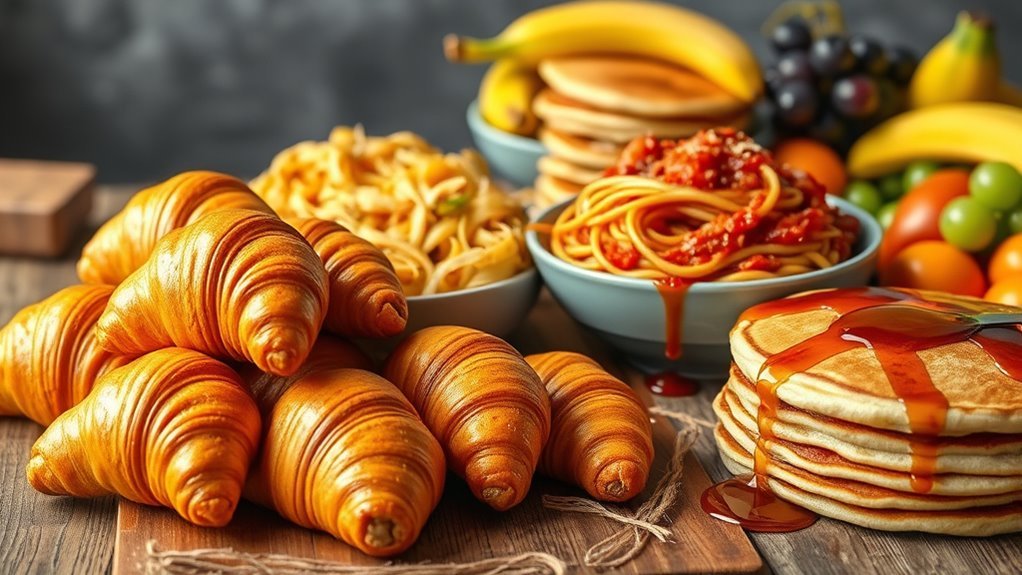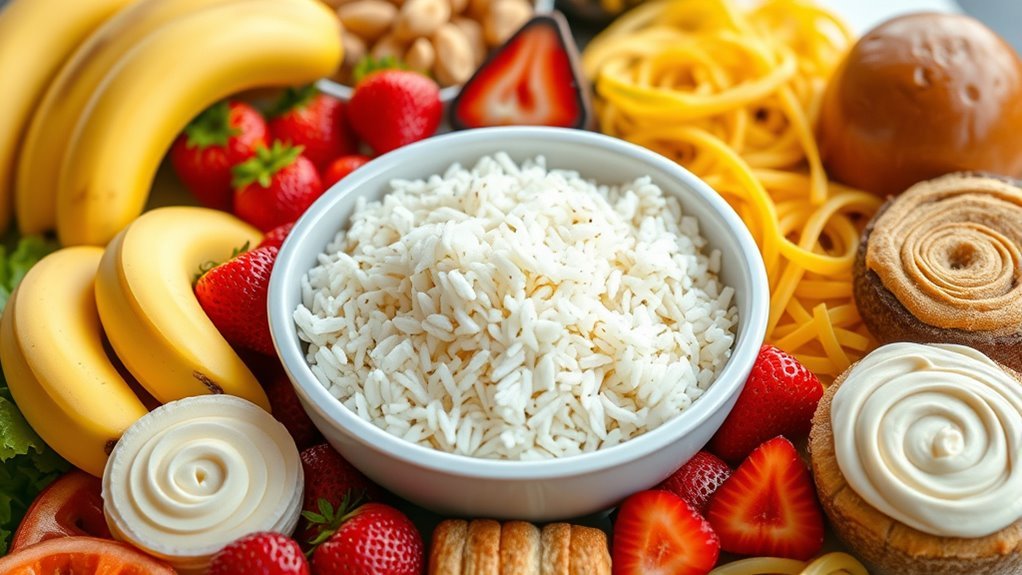On a keto diet, you can’t eat high-carb foods like sugary snacks, grains, and starchy vegetables. Foods such as chips, cakes, rice, potatoes, and certain fruits like bananas and grapes can spike your blood sugar, disrupting ketosis. Legumes and beans also contain too many carbs, hindering weight loss. Instead, opt for low-carb alternatives like nuts, cheese, and berries to stay on track. There’s plenty more to discover about maintaining your keto lifestyle effectively.
High-Carb Foods

When you’re following a keto diet, it’s crucial to steer clear of high-carb foods, as they can greatly hinder your progress. High-carb snacks, like chips and granola bars, often contain hidden sugars that can kick you out of ketosis. Unhealthy desserts, such as cakes and ice creams, are also off-limits. These treats not only spike your blood sugar but can lead to cravings that make sticking to your diet more challenging. Instead, focus on low-carb alternatives like nuts, cheese, or dark chocolate in moderation. By replacing those high-carb options with healthier choices, you’ll maintain your energy levels and enjoy the freedom that comes with successful weight loss on a keto diet. Stay informed and make empowered choices!
Sugary Snacks and Desserts

High-carb foods aren’t the only culprits to watch out for on a keto diet; sugary snacks and desserts can also derail your efforts. Foods high in sugars can spike your blood glucose levels, pushing you out of ketosis. Instead of traditional sweets, consider exploring sugar substitutes like erythritol or stevia. These alternatives can satisfy your sweet tooth without compromising your carb limits. Thankfully, there are plenty of keto-friendly desserts available that use these substitutes, such as almond flour brownies or coconut flour cookies. By choosing wisely, you can enjoy treats while staying aligned with your dietary goals. Embracing these options offers you the freedom to indulge without sacrificing your commitment to the keto lifestyle.
Grains and Starches

When following a keto diet, you’ll need to be mindful of high-carb grains and starchy vegetables that can greatly impact your carbohydrate intake. Foods like rice, pasta, and potatoes are staples in many diets, but they can hinder your progress on keto. Instead, focusing on low-carb alternatives is essential for maintaining ketosis and achieving your health goals.
High-Carb Grains
While many diets emphasize the importance of whole grains, the keto diet takes a different approach by considerably limiting high-carb grains and starches. These include items like wheat, rice, and corn, which can spike your blood sugar and hinder ketosis. If you’re looking for gluten free options, be aware that many gluten free grains, such as quinoa and oats, are also high in carbs and may not fit into your keto lifestyle. Instead, consider incorporating whole grain alternatives like almond flour or coconut flour for baking. These options provide lower carb counts while still offering some nutritional benefits. Remember, the key is to focus on maintaining a low carbohydrate intake to achieve your desired results on the keto diet.
Starchy Vegetables
Although they may be nutritious, starchy vegetables like potatoes, sweet potatoes, and corn are typically restricted on the keto diet due to their high carbohydrate content. You might find it challenging to include these in your meals, but there are plenty of keto-friendly vegetables to enjoy instead.
Here’s a quick comparison of starchy vegetables and their alternatives:
| Starchy Vegetable | Keto-Friendly Alternative |
|---|---|
| Potatoes | Cauliflower |
| Sweet Potatoes | Zucchini |
| Corn | Cabbage |
Certain Fruits
Maneuvering the world of the keto diet can be tricky, especially when it comes to fruit choices. While fruits are often considered healthy, certain varieties can be high in sugars and carbs, making them unsuitable for your keto lifestyle. Here are some fruits to limit or avoid:
- Bananas
- Grapes
- Pineapples
Instead, opt for healthy alternatives that align with keto guidelines. Berries, particularly raspberries and blackberries, are lower in carbs and can satisfy your sweet tooth without derailing your efforts. Avocados, though technically a fruit, are a fantastic choice, packed with healthy fats and fiber. By selecting the right fruit varieties, you can enjoy your diet while staying in ketosis and feeling free!
Legumes and Beans
When you’re following a keto diet, it’s important to contemplate the high carb content of legumes and beans, which can hinder your progress. While they offer beneficial protein and fiber, their carbohydrate levels often exceed the limits set by a typical keto plan. If you’re looking for alternative protein sources, you’ll need to explore options that align more closely with your dietary goals.
High Carb Content
While legumes and beans are often praised for their nutritional benefits, they can pose a significant challenge for those following a keto diet due to their high carbohydrate content. If you’re serious about maintaining carbohydrate awareness, you’ll want to limit these foods in your meal planning.
Consider the carb counts of common legumes:
- Chickpeas: Over 40g of carbs per cup
- Black beans: Around 40g of carbs per cup
- Lentils: Close to 36g of carbs per cup
These numbers can quickly push you over your daily carb limit. Instead, explore low-carb alternatives that align with your keto goals while still providing essential nutrients. Embracing this awareness is key to achieving your desired freedom on the keto journey.
Alternative Protein Sources
Although legumes and beans are often considered staple sources of protein in many diets, they may not be the best fit for a ketogenic lifestyle due to their high carbohydrate content. While they provide plant-based proteins, the carbs can hinder your ketosis goals. Instead, consider diversifying your protein sources with lower-carb options like seafood.
| Protein Source | Carb Content (per 100g) |
|---|---|
| Lentils | 20g |
| Chickpeas | 27g |
| Salmon | 0g |
| Shrimp | 0g |
Opting for seafood not only keeps your carb intake low but also offers healthy fats and essential nutrients. Remember, you have the freedom to choose the best protein sources that align with your keto journey!
Processed and Packaged Foods
As you begin the keto diet, it’s crucial to be mindful of processed and packaged foods, which often contain hidden carbohydrates that can derail your progress. These items can sneak in sugars and starches that might not align with your dietary goals.
To stay on track, consider avoiding:
To maintain your keto diet, steer clear of snacks, meats, and meals that contain hidden sugars or grains.
- Packaged snacks that list sugar or grains among the first few ingredients.
- Processed meats that may include fillers or sugars in their formulations.
- Ready-made meals that often use sauces or marinades high in carbohydrates.
Focusing on whole, unprocessed foods allows you the freedom to enjoy your meals without the worry of unintentional carb intake. Always read labels carefully and prioritize fresh ingredients for the best results on your keto journey.
Starchy Vegetables
When starting a keto diet, it’s essential to recognize that starchy vegetables can greatly impact your carbohydrate intake. Foods like potatoes, corn, and peas are high in carbs and can hinder your progress. Instead, consider keto-friendly alternatives such as leafy greens, zucchini, or cauliflower. These options are not only low in carbohydrates but also versatile in vegetable preparation, allowing you to create delicious dishes without sacrificing flavor. You can spiralize zucchini into noodles or mash cauliflower as a substitute for potatoes. Embracing these alternatives gives you the freedom to enjoy satisfying meals while staying within your carb limits. By being mindful of your choices, you can successfully navigate your keto journey and maintain your health goals.


